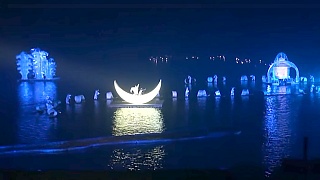The low-down on the Chinese writing system.
Great videos ... [640],shadow=true,start=,stop=See - it's very easy really ;)
Live more ...
 Chinese language characters
Chinese language charactersThe low-down on the Chinese writing system.
Great videos ... [640],shadow=true,start=,stop=See - it's very easy really ;)

|
An awesome romantic comedy movie for Valentine's Day.
Four couples with love, life and romance.
Filmed in China (BeiJing and ShenZhen) and Italy (Rome, Matera). Directed by Liu Jiang ...
Trailer ...
|

|
Tachuan is 5 km northeast of HongCun, on the way to HuangShan.
|

|
GanSu province.
With Walk East ...
|

|

|
Amazing craftsmanship (actually, so good it is art) and culinary skills ...
|

|
YangShuo, GuangXi province.
|

|
Caroline Esmeralda van der Leeuw is a Dutch pop and jazz singer. Here, live in Budapest, Hungary ...
|

|